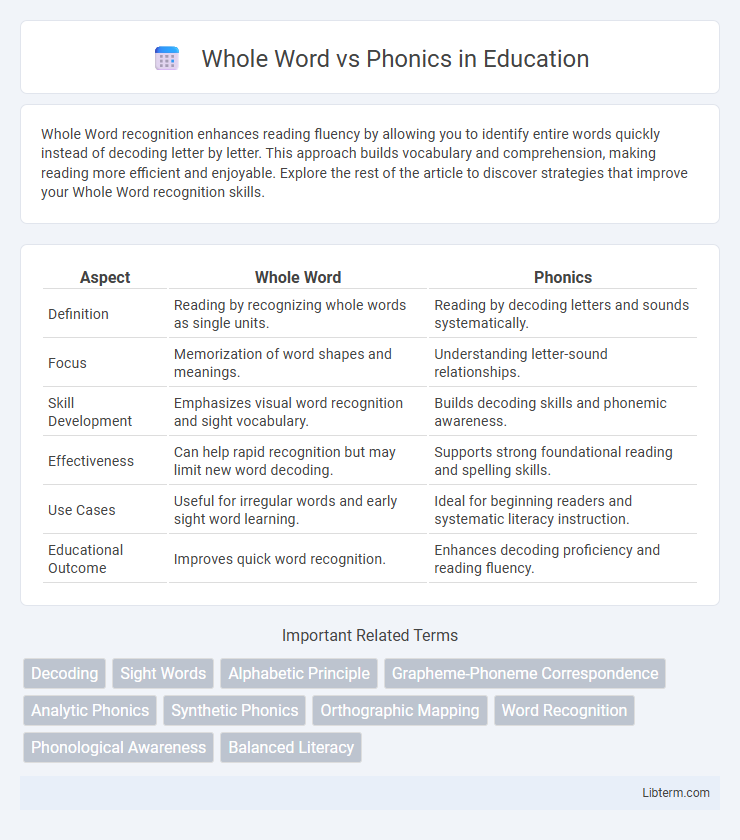Whole Word recognition enhances reading fluency by allowing you to identify entire words quickly instead of decoding letter by letter. This approach builds vocabulary and comprehension, making reading more efficient and enjoyable. Explore the rest of the article to discover strategies that improve your Whole Word recognition skills.
Table of Comparison
| Aspect | Whole Word | Phonics |
|---|---|---|
| Definition | Reading by recognizing whole words as single units. | Reading by decoding letters and sounds systematically. |
| Focus | Memorization of word shapes and meanings. | Understanding letter-sound relationships. |
| Skill Development | Emphasizes visual word recognition and sight vocabulary. | Builds decoding skills and phonemic awareness. |
| Effectiveness | Can help rapid recognition but may limit new word decoding. | Supports strong foundational reading and spelling skills. |
| Use Cases | Useful for irregular words and early sight word learning. | Ideal for beginning readers and systematic literacy instruction. |
| Educational Outcome | Improves quick word recognition. | Enhances decoding proficiency and reading fluency. |
Understanding Whole Word and Phonics Approaches
The Whole Word approach emphasizes recognizing entire words as single units, aiding rapid reading fluency by memorizing visual patterns without breaking words into sounds. Phonics approach teaches reading by decoding words through systematic instruction of letter-sound relationships, fostering stronger foundational skills in spelling and pronunciation. Understanding the differences helps educators tailor reading instruction to student needs, balancing visual recognition with phonetic decoding for comprehensive literacy development.
Key Differences Between Whole Word and Phonics
Whole Word instruction emphasizes recognizing entire words as single units, fostering sight vocabulary development without breaking down phonetic components, whereas Phonics focuses on decoding words by associating letters with their corresponding sounds. Whole Word methods enhance reading fluency through memorization of word shapes, while Phonics builds foundational skills for decoding unfamiliar words using systematic letter-sound relationships. The primary difference lies in Whole Word's reliance on visual memory contrasted with Phonics' analytical approach to sound-letter correspondence for literacy acquisition.
Historical Background of Reading Instruction
The historical background of reading instruction reveals a long-standing debate between whole word and phonics methods, with whole word approaches emerging prominently in the early 20th century through the "look-say" method popularized by the McGuffey Readers. Phonics instruction, emphasizing the systematic teaching of letter-sound relationships, gained renewed prominence in the mid-20th century amid critiques of whole word methods for lacking scientific rigor and struggling with decoding unfamiliar words. Modern reading instruction often integrates both approaches, influenced by cognitive research from the National Reading Panel highlighting phonics as essential for early literacy development.
Benefits of the Whole Word Method
The Whole Word method enhances reading fluency by enabling learners to quickly recognize and memorize entire words, which improves reading speed and comprehension. This approach supports early vocabulary development and encourages the recognition of context clues, fostering a more natural and engaging reading experience. Whole Word instruction often benefits students with diverse learning needs by reducing decoding difficulties commonly associated with phonics-based approaches.
Advantages of Phonics-Based Learning
Phonics-based learning enhances reading skills by systematically teaching the relationship between letters and sounds, resulting in improved decoding and word recognition. This method supports early literacy development by promoting strong foundational skills necessary for fluent reading and spelling. Research shows that phonics instruction leads to higher reading achievement, especially for struggling readers and those learning English as a second language.
Common Criticisms of Each Approach
The whole word approach faces criticism for encouraging memorization without understanding phonetic patterns, which may hinder decoding unfamiliar words. Phonics instruction is often criticized for being overly rigid, ignoring the complexities of English spelling and potentially disengaging learners. Both methods have limitations, with whole word approaches sometimes lacking in systematic instruction and phonics approaches sometimes failing to promote fluency and comprehension.
Research Findings: Effectiveness in Literacy Development
Research findings consistently show that phonics instruction enhances literacy development by improving decoding skills and word recognition in early readers. Whole word methods emphasize memorization of entire words, often resulting in slower reading acquisition and limited generalization to new vocabulary. Evidence from longitudinal studies indicates phonics-based approaches lead to stronger reading comprehension and spelling abilities over time.
Hybrid Models: Integrating Whole Word and Phonics
Hybrid models combine whole word recognition and phonics instruction to optimize reading development by leveraging the strengths of both approaches. These models incorporate systematic phonics to teach decoding skills while using whole word strategies to build sight vocabulary and reading fluency, facilitating better comprehension and retention. Research shows hybrid instruction supports diverse learning needs, enhancing literacy outcomes across early and struggling readers.
Choosing the Right Approach for Different Learners
Choosing the right approach between whole word and phonics depends on individual learner needs and cognitive strengths. Phonics instruction benefits students who thrive on decoding skills and systematic letter-sound relationships, improving reading fluency and comprehension over time. Whole word methods suit learners who excel in visual memory and contextual understanding, enabling faster recognition of familiar words without relying solely on phonetic decoding.
Future Trends in Reading Instruction
Future trends in reading instruction emphasize a balanced approach that integrates both whole word recognition and phonics to enhance literacy development. Advances in neuroeducation and adaptive learning technologies support personalized reading programs, leveraging artificial intelligence to tailor phonics drills and whole word exposure according to individual student needs. Research from institutions like the International Literacy Association highlights the growing importance of multimodal strategies, combining visual word recognition with phonemic awareness to improve reading fluency in diverse learning environments.
Whole Word Infographic

 libterm.com
libterm.com